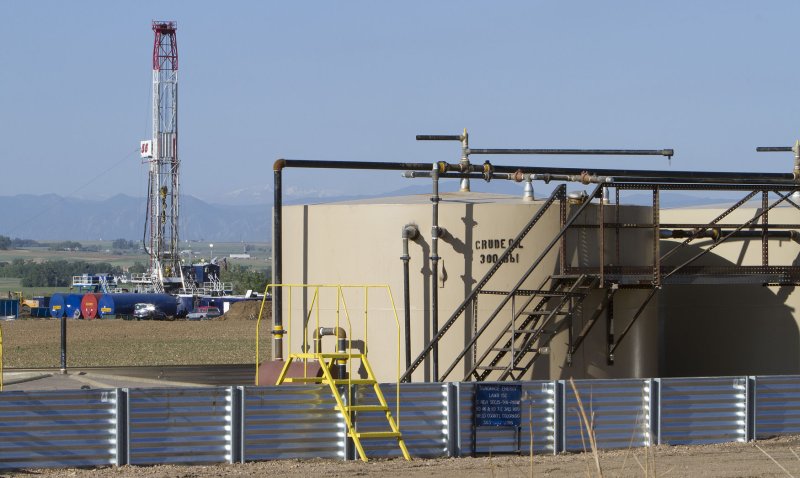 In Sherry Gobble’s house, the water runs toxic.
In Sherry Gobble’s house, the water runs toxic.
Gobble, who lives alongside Duke Energy’s Buck Steam Station in a Rowan County community called Dukeville, discovered six months ago that water in her family’s well contains the carcinogen hexavalent chromium, also known as chromium-6. Since then, they have armed themselves with bottled water and a growing pile of empty jugs they fill up across town where they know the water isn’t tainted.
She believes the potentially cancer-causing contaminant is seeping in from the leaking coal ash pond next door. It’s a charge Duke Energy vigorously denies.
Dukesville, NC: Don’t drink the water, locals and activists warn
Earthquake Rattles Wichita, Tulsa; 4.4-Magnitude Tremor Felt Widely in Kansas, Oklahoma
A 4.4-magnitude earthquake rattled a large part of Kansas and Oklahoma Thursday afternoon, just one day after residents had been ducking for cover from tornado warnings and severe thunderstorms.
The U.S. Geological Survey said the quake struck at 1:01 p.m. CDT. The epicenter was 7 miles east-southeast of Harper, Kansas, or about 43 miles southwest of Wichita, Kansas. There have been no immediate reports of damage. Wichita television station KAKE-TV said officials near the epicenter in Harper County, Kansas, reported no known damage.
U.S. Appeals Court Orders Disclosure of Secrets in Chevron Oil Pollution Case
 One might assume that after 21 years of litigation, all the sordid details surrounding the epic Chevron oil pollution case had been made public. Not so. A three-judge federal appeals court panel in Richmond, Va., ruled unanimously on Tuesday that plaintiffs’ lawyers accused of fraud against the oil company must reveal the contents of documents that had been confidential and could hold new information about wrongdoing.
One might assume that after 21 years of litigation, all the sordid details surrounding the epic Chevron oil pollution case had been made public. Not so. A three-judge federal appeals court panel in Richmond, Va., ruled unanimously on Tuesday that plaintiffs’ lawyers accused of fraud against the oil company must reveal the contents of documents that had been confidential and could hold new information about wrongdoing.
The appellate ruling constitutes the latest victory for Chevron (CVX) as the company seeks to nullify a $19 billion judgment imposed against the company in 2011 by a trial court in Ecuador. The Andean nation’s supreme court has affirmed Chevron’s liability while halving the damages to a still-substantial $9.5 billion.
EU climate change chief: Obama has six months to take substantial action
 Barack Obama has six months to deliver on the promises he made in a rousing speech at the United Nations climate change summit, Europe’s climate action commissioner said.
Barack Obama has six months to deliver on the promises he made in a rousing speech at the United Nations climate change summit, Europe’s climate action commissioner said.
Obama, in a well-received address on Tuesday, promised the United States would play a leading role in reaching an international agreement to fight climate change, due to be finalised in Paris at the end of next year.
Connie Hedegaard, who is responsible for ensuring the European Union meets its climate change obligations, told the Guardian that after the president’s speech raised expectations, other countries, especially the rising economies of China, India and Brazil, will be looking closely at what the US has to offer in six months.
How a 3-Minute Film Is Making a Long-Term Difference on Climate Change
 This is the story of how a three-minute film watched by over 120 world leaders at the United Nations this morning was produced by a newly empty nested mother of three who had never produced a minute of film before.
This is the story of how a three-minute film watched by over 120 world leaders at the United Nations this morning was produced by a newly empty nested mother of three who had never produced a minute of film before.
It began 26 years ago when my friend, Cindy Horn, and I were pregnant with our first born and concerned about what the scientific community was telling us about the man-made threat to the planet that was soon to welcome our innocent babies.
Rockefellers, Heirs to an Oil Fortune, Will Divest Charity of Fossil Fuels
 The family whose legendary wealth flowed from Standard Oil is planning to announce on Monday that its $860 million philanthropic organization, the Rockefeller Brothers Fund, is joining the divestment movement that began a couple years ago on college campuses.
The family whose legendary wealth flowed from Standard Oil is planning to announce on Monday that its $860 million philanthropic organization, the Rockefeller Brothers Fund, is joining the divestment movement that began a couple years ago on college campuses.
The announcement, timed to precede Tuesday’s opening of the United Nations climate change summit meeting in New York City, is part of a broader and accelerating initiative.
Fracking may put drinking water supply at risk for many countries, study finds
 A new study by the World Resources Institute finds that many places with water scarcity are using too much of their resources on fracking. "Eight of the top 20 countries with the largest shale gas resources face arid conditions or high to extremely high baseline water stress where the shale resources are located; this includes China, Algeria, Mexico, South Africa, Libya, Pakistan, Egypt, and India," the study states.
A new study by the World Resources Institute finds that many places with water scarcity are using too much of their resources on fracking. "Eight of the top 20 countries with the largest shale gas resources face arid conditions or high to extremely high baseline water stress where the shale resources are located; this includes China, Algeria, Mexico, South Africa, Libya, Pakistan, Egypt, and India," the study states.
The United States is also at risk, according to the study, since many of the places inside the United States that are good for fracking are going through a drought or generally have low water supply.
To drill a fracking well takes 5 million gallons of water, on average. States like Texas have a strong fracking industry, but lack of water supplies has forced frackers to import water from elsewhere to continue their business.
More Articles...
Page 36 of 200

 Environmental Glance
Environmental Glance






























